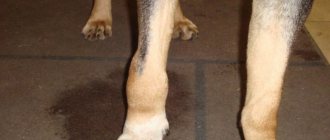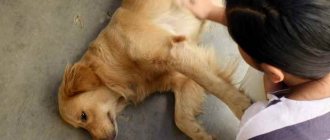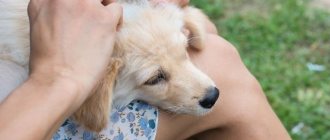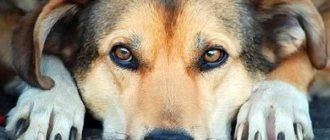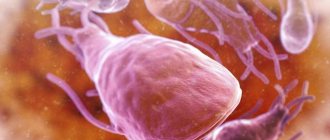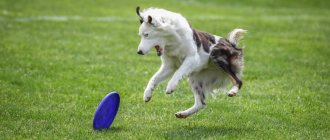What is an umbilical hernia in dogs
In essence, the definition of an “umbilical hernia” is a kind of stretched sac of abdominal tissue containing parts of internal organs (usually the omentum and intestines). Through a hole in the abdominal wall (hernial orifice) it protrudes out and is clearly visible to the naked eye. Often, it is impossible to set the internal organs due to the fusion of the omentum with the sac, so only surgical intervention can help the dog.
The hernial orifice (the very place where the hernia prolapses) can be of a natural (congenital) or traumatic nature, but in any case, under certain conditions, they can infringe on the sac. In turn, this threatens necrosis of intestinal tissue and the development of sepsis, which pose a high danger to the life of the pet. Making a final decision regarding the operation depends on the size of the hernia and its position: it is quite possible that in the near future it will be possible to get by with just observation and monitoring of its condition.
Reasons for appearance
A hernia in a dog can be congenital or acquired. In puppies, this pathology is often diagnosed in the navel area. It can form during childbirth if the puppy was incorrectly removed from the womb. After birth, the umbilical ring should normally close. But in the case of pathologies of pregnancy in bitches, it may be weak in newborn puppies and does not heal.
The causes of an acquired hernia in the abdomen can also be:
- complications after surgery;
- peritoneal injuries, falls, high jumps;
- chronic constipation;
- ascites;
- excessive physical activity;
- numerous pregnancies and bearing large fetuses;
- atrophy of the inguinal cord;
- diseases of the lungs and cardiovascular system, in which intra-abdominal pressure increases;
- a constantly full bladder;
At risk are dogs with a weak constitution, decreased muscle tone (usually elderly), as well as those that move little.
What to do if a dog marks in an apartment and how to deal with the animal’s inappropriate behavior? Read useful information.
How to choose a bear-type dwarf Spitz puppy, how to keep and raise the animal is written on this page.
Why is a hernia on the stomach dangerous for an animal?
In small puppies, the bulge on the belly is usually not painful or inflamed. Many owners hope that the hernia will go away on its own. But its main danger is that pinching can occur at any moment. The skin becomes very stretched, blood circulation in the pinched area is disrupted, swelling and inflammation appear. If the blood supply is not restored, necrosis of surrounding tissues, infection and sepsis will occur. This can lead to the death of the dog without timely surgical intervention.
Why does it appear
The development of an umbilical hernia in dogs very rarely depends on their breed, but often the pathology is diagnosed in puppies and bitches after pregnancy. There may be several reasons for its appearance in each case.
Did you know? The fattest dog in the Guinness Book of Records is the border collie Cassie. With normal values for the breed within 20 kg, the animal weighed 58 kg, which was the reason for its fame.
In puppies
Puppy hernia is usually a congenital disorder. During labor, the umbilical opening should shrink, but if it is enlarged or has an irregular structure, this does not happen. If such a defect is observed in several puppies from a litter at once, we can talk about their genetic predisposition to this, although we should not exclude the possibility of the babies receiving a birth injury when the mother bites the umbilical cord too close to the surface of the abdomen. This may well cause the puppy to quickly die or disrupt the natural processes of sealing the umbilical opening.
The second, no less common cause of a hernia in small puppies is overstrain of the abdominal muscles or excessive intra-abdominal pressure. Therefore, to protect babies from trouble, you should not carry and cuddle them at an early age until their muscles become stronger.
In adult dogs
Among the main reasons for the appearance of umbilical hernias in adult animals are mechanical injuries to the abdomen, complications in the postoperative period, disorders associated with frequent pregnancies in female dogs, and intestinal problems. Each base has its own characteristics, which are worth knowing about in order to eliminate the problem in a timely manner.
Injuries
Unlike a newborn puppy, the umbilical ring of an adult dog is already closed by a commissure, but it can diverge under certain conditions. One of them is mechanical trauma to the abdomen as a result of a blunt blow or prolonged pressure on the abdominal wall from the outside. If the hernial orifice turns out to be open again, then over time a bag with internal organs may well appear from them, which, with increased activity of the dog, will fall out more and more.
Important! If a hernial lump has already appeared on your pet’s stomach, you need to very carefully monitor changes in its shape and size. Even if there is no surgery, you will have to reduce the physical stress on the dog as much as possible, preventing it from jumping from heights or running fast.
After operation
If your dog has undergone abdominal surgery, the muscles in the abdominal walls will not regain their former tone over the next few weeks. The slightest load on them can lead to divergence of the already healed umbilical ring. In addition, in some cases, it is damaged during the operation itself on the stomach or intestines, then the likelihood of developing pathology will be much higher, and swelling in the umbilical area will become clearly visible within 2-3 days after surgery.
From frequent pregnancy
Frequent multiple pregnancies in themselves are a great stress for the bitch’s body, which simply does not have time to recover. A large belly and considerable weight of the offspring is the main reason for increased pressure on the abdominal walls, so it is not surprising that in areas with very thin skin, ruptures are possible. Even a minor mechanical trauma from the outside will only contribute to this, just like difficult labor with strong pushing.
Intestinal problems
Disturbances in the intestines are quite often accompanied by excessive flatulence and bloating, due to which it can significantly increase in size. If this happens infrequently, then there is nothing to worry about, but with regular pressure on the inner walls of the abdominal cavity, they will gradually stretch, sometimes leading to cracks in the adhesions of the umbilical ring. Frequent constipation also leads to similar consequences.
Other reasons
Sometimes the cause of an enlarged abdomen and increased pressure on the abdominal walls is ascites (dropsy). Free fluid accumulates in the abdominal cavity and gradually stretches it, pressing downward. As in the case of pregnancy, the adhesions of the umbilical ring may simply not withstand the load and crack.
Did you know? The record for fertility among dogs belongs to a Neapolitan mastiff named Tia. In 2004, she gave birth to 24 puppies, of which 20 babies survived and turned out to be completely healthy, costing $1,800 each.
How to identify a hernia in a puppy?
If the owner of the woman in labor is attentive and caring, then he will regularly examine the babies. You do not need to be a qualified veterinarian to identify an umbilical hernia in a dog or newborn puppy. With pathology, a more convex area is noticeable on the tummy than the rest of the area. There will be a small, protruding ball on the skin.
Don't start panicking right away. Umbilical hernias often occur in puppies, and in almost all of them they disappear on their own over the next few days of development.
What are the types of umbilical hernias in dogs?
Based on the structure and main characteristics of umbilical hernias, all such formations can be divided into several main groups: false, true, mobile and hard. These features directly influence the choice of treatment strategy.
False
False umbilical hernias are presented in the form of a small soft ball located next to the navel. If desired, you can straighten it with your fingers, since instead of parts of internal organs, the pouch contains fatty tissue. Over time, fat deposits form in its place and the hernia will become less mobile. This option does not pose any particular danger to your pet’s health, but to make sure of this, it is still better to consult a veterinarian.
True
A true hernia is precisely the same pathology in which the umbilical ring opens with a certain part of one or another abdominal organ coming out: usually the intestines.
Movable
In most cases, it is the false hernia that is mobile, although in the initial stages of formation this is also typical for the true hernia. If the umbilical ring does not prevent the prolapsed organ from being placed back into the abdominal cavity, this is definitely a movable option. How long it will remain like this largely depends on external factors.
Hard
A hard, immobile hernia is one of the most dangerous types of pathology, characterized by a sharp narrowing of the umbilical ring after the loss of soft tissue. It no longer straightens out, so the surface of the internal organs is pinched. Of course, there is no need to talk about their full-fledged work, which often threatens not only a deterioration in well-being, but also death.
Learn more about the types of hernias in dogs, symptoms and treatment.
How to treat hernia in puppies?
Small hernias most often do not require treatment and close on their own when the puppy reaches about six months of age. Sometimes owners try to cure a hernia in their small pets with a coin attached to the hernia ring with a bandage. Such manipulations should only be carried out with the permission of a veterinarian - the effectiveness of folk remedies is often exaggerated, and they cannot replace surgical treatment.
More modern methods to speed up the closure of the umbilical ring are all kinds of bandages and pressure bandages, specially designed for puppies suffering from a hernia, and abdominal massage. Monitoring by a doctor is required - if the hernia does not close on its own or begins to grow, conservative treatment will not be possible.
The veterinarian may also use alcohol injections to heal the hernia. In this case, ethyl alcohol is injected into certain areas of the hernial ring, causing inflammation and overgrowth of the ring.
Large hernias must be sutured to avoid strangulation. Usually six-month-old puppies are operated on, but recently hernias are often repaired in 9-10-week-old babies.
To prevent the occurrence of a hernia, especially if there is a risk of hereditary weakness of the umbilical ring and abdominal muscles in puppies, you should handle the babies carefully. You should not lift them by their front or hind legs; you should not allow the puppies to stand on their paws too early, or pull themselves up, leaning their front paws on the side of the box or crate in which they are located.
The phenomenon is quite common. An animal may have a congenital pathology or an acquired one. Treatment of umbilical hernia in dogs is impossible; the only way out is reduction and suturing. The problem cannot be underestimated; a hernia is fraught with serious complications, including death. In this article we will talk about the causes of umbilical hernias in dogs of puppyhood and adults. Let's look at the types of such hernias and learn what to do if a problem arises.
How to tell if your dog has an umbilical hernia
An umbilical hernia is easy to detect by visually examining the dog or scratching its belly. Outwardly, it resembles a spherical tumor, often soft to the touch. The non-strangulated version does not in any way prevent the pet from moving, playing and eating, but if the umbilical ring nevertheless narrows, this can be determined by the following additional symptoms:
- pain factor, causing the dog to growl, whine, arch his back and limit his movements;
- decreased appetite or complete refusal to eat;
- problems with defecation, which are also often associated with pain in the abdominal area, back and neck;
- increased body temperature;
- increased breathing and increased heart rate up to 150 beats per minute for adults and over 200 for puppies;
- lack of coordination due to the dog's slow and careful movements (associated with painful hernia).
Due to the long coats of some breeds, it can be difficult to spot a small bump. But if it is not there, this does not mean that the problem was avoided. Carefully feel the navel area: it is likely that with light pressure it will be easier to determine it under your fingers than by eye.
Preventing the development of a hernia in a pet
Hernial neoplasms are not so common; pathology can be easily avoided if you monitor the pet’s condition, examine its body, respond to changes in mood, and periodically show it to the veterinarian. To prevent the appearance of a muscle tear, it is enough to follow the rules:
- It is necessary to promptly treat problems of the digestive system and other disorders in the functioning of the body, normalize nutrition, and monitor the process of bowel movements;
- It is better to sterilize females not intended for bearing and giving birth to offspring (the same applies to males);
- After injuries or falls, it is important to have the animal examined in a clinic;
- The main condition for keeping a dog is the required amount of physical activity, proper training, regular walking (to avoid obesity or excessive strain on the muscles);
- To operate on a pet (for any reason), select a trusted clinic, and during the recovery period you need to strictly follow the veterinarian’s instructions and take care of the sutures;
- Elderly animals are fed special foods with a high calcium content;
- Dogs are purchased only from trusted breeders. It is important to first get acquainted with the puppy’s parents and find out about their chronic diseases.
To avoid the appearance of a hernia in puppies, a specialist obstetrician is invited during childbirth to help the female without injuring the offspring.
Any hernial neoplasm needs to be examined by a doctor. Therefore, if a lump (reducible or hard) appears, it is necessary to contact your local veterinarian and undergo examination, and then rehabilitation.
Umbilical hernia is common in dogs. Let's look at what to do if your dog has an umbilical hernia, its treatment, and whether surgery is necessary. It is usually congenital, but is sometimes observed in adults. It is important to understand that it is dangerous to your pet's health. Even with a small size and simple reduction, entrapment can occur.
A hernia sometimes manifests itself with an increase in intra-abdominal pressure and increased stress on the peritoneal muscles. It is a hernial orifice with a prolapsing hernial sac. The owner usually notices a small, mobile swelling. In this case, the dog does not suffer from discomfort. Its sizes vary significantly.
What to do at home
Whatever the characteristics of the hernia, you should not try to reduce it yourself. One careless movement can cause pinching or rupture of internal organs, which can lead to the death of the dog.
Before visiting the veterinarian and drawing up a clear plan for further action, you should limit the dog’s physical activity, avoiding excessive stress. Nutrition, as before, should be balanced in vitamin and mineral composition, but must be free of solid, difficult-to-digest particles. Good condition of the digestive system and the absence of constipation reduce the likelihood of a strangulated hernia.
Important! If your dog has any health conditions, you should definitely inform your veterinarian about them before surgery. First of all, this concerns individual intolerance to a specific group of drugs and problems with cardiac activity.
Symptoms and diagnosis
The main symptom of an umbilical hernia is swelling in the dog's navel area. It may protrude even more during certain activities, such as when the dog stands on its hind legs, barks, or tenses.
The small size and painlessness of a hernia does not mean that the formation does not pose a danger to the health and life of the dog. In acute cases of strangulated hernia, the following symptoms may appear:
Hernia
- educational pain;
- a hernia may be accompanied by inflammation;
- the temperature of the skin above the inflammation zone increases;
- vomiting and lack of appetite;
- indigestion, constipation;
- malaise and fever;
- depression and reluctance to communicate with a person.
An umbilical hernia in dogs is usually easily diagnosed by a veterinarian by palpation. If complications occur, the dog may need an x-ray or ultrasound to determine the severity of the compression of the abdominal organs.
Surgery to remove umbilical hernia in dogs
The only way to remove a dog’s umbilical hernia is surgery, and drug treatment is prescribed only after surgery to prevent the development of inflammation and speed up the rehabilitation period.
If the internal organs have not yet entered the hernial ring, the veterinarian will carefully straighten the peritoneum and sew up the hole, which will prevent relapses and problems in the future. In case of protrusion of the sac along with the internal organs, it is necessary to perform a strip operation with dissection of the ring and inspection of the contents of the hernia. If there are no signs of sepsis or inflammation, the organs are placed back into the abdominal cavity and sutured in the usual way. In case of tissue necrosis, it is necessary to additionally excise the damaged areas and thoroughly clean the area where they are located. Of course, the recovery period will take a little longer.
Symptoms
Externally, it is not difficult to identify a hernia in a dog’s abdomen. This is a bulge covered with skin. Its sizes can be very different. But in addition to external protrusion, the pathology is accompanied by other manifestations characteristic of a violation of certain functions of the abdominal organs involved in the process.
The clinical picture for an uncomplicated reducible hernia is usually the same:
- swelling of varying degrees, round or pear-shaped;
- gradual increase in hernia;
- skin mobility in the pathological area;
- identification of the hernial ring upon palpation;
- the pain is mild.
With irreducible hernias, the swelling is denser, the skin is very tense, and it is difficult to displace it. The animal's digestion is disrupted, its appetite worsens, problems with stool appear, and when the hernia is inflamed, the temperature rises. Irreversible hernias are characterized by a pronounced tympanic sound.
A strangulated hernia is diagnosed in 3-5% of cases. Clinical manifestations depend on which organ is strangulated, as well as on the degree of vascular compression. Usually the dog’s temperature rises, pain appears on palpation, the skin is tense and motionless.
How to care for your dog after surgery
After surgery, the animal should be provided with maximum peace by arranging a bed in a quiet place where the dog will not be disturbed. To relieve pain, the pet is given analgesics, and antibiotics are injected to prevent inflammation. Until the stitches are removed, the dog remains in the bandage, and the owner must control that he does not remove it.
In terms of nutrition, you should adhere to the general rules: on the first day after surgery, give only water or chicken broth, and then introduce lean boiled meat, rice, and fermented milk products into the diet (starting from the 4th day of rehabilitation). You can’t force the dog to move a lot, but if it gets up from its place on its own and asks to go for a walk, you can take it out for a short time.
It is useful to read about the postoperative period and treatment of complications after pyometra in dogs.
Treatment methods
The veterinarian determines treatment tactics based on the nature, location, size of the hernia, and the age of the dog. In most cases, they resort to surgery. But some situations can be corrected using conservative methods.
Conservative
If the puppy is not yet 2 months old and a hernia is detected on his stomach, you can try to solve the problem without surgery. A reducible hernia can be repaired. You can massage several times a day. Gently massage the abdomen in a clockwise direction. This will help strengthen the abdominal wall and retract the protrusion.
You can repair a hernia in a puppy by placing a coin on it and securing it with a bandage. Remove after 2 weeks. Another way to reduce protrusion is to inject rubbing alcohol into several points around it. Such manipulations can only be done according to the instructions of a veterinarian and are acceptable only for small puppies.
Operational
Very often, non-invasive methods of combating abdominal hernia are ineffective and can lead to complications. Therefore, in most cases surgery is required. The method of removing a hernia is selected individually, taking into account the size of the defect, the presence of inflammation and other factors.
The purpose of the operation is to restore the functionality of the organs involved in the pathological process. Before the intervention, the dog is put on a starvation diet for 12-24 hours. The intestines and bladder should be empty at the time of surgery. Bladder catheterization is often performed.
Stages of surgery for a reducible hernia:
- Fixing the animal on its back.
- Introduction of general anesthesia.
- Excision of the skin over the protrusion.
- Separation of the peritoneum to the side by 1-2 cm.
- Reduction of the hernia to its original position.
- Applying sutures to the hernial ring.
- Treating the wound with an antiseptic.
If fusion of the hernial contents with the peritoneum has occurred, the skin is dissected and the site of adhesions is identified. An incision is made in it and the peritoneum around the commissure is cut off. The hernial sac is adjusted and sutures are applied. It is recommended to remove the hernial sac if fusion occurs not only with the peritoneum, but also with the skin.
What to do if a dog has diarrhea and vomiting and how to treat the animal at home? We have the answer!
Instructions for using Milprazone tablets for small breed dogs are described on this page.
Follow the link and learn about the rules of nutrition and diet for urolithiasis in dogs.
Postoperative period
After surgery, rehabilitation follows. In order for your dog to recover faster, it is necessary to perform a number of measures:
- Regularly treat seams with an antiseptic.
- Give antibiotics to prevent tissue infection.
- Stick to a diet. Food should be easily digestible. Avoid dry food and foods that cause fermentation in the intestines and bloating.
- Ensure complete rest and avoid any stress for the first few days after surgery. Gradually adhere to a regimen of moderate exercise as directed by your doctor.
- Wear a special postoperative bandage.
- If necessary, give painkillers (Ketanov, Travmatin) for no more than 5 days.
Treatment
This deviation can be diagnosed based on the following characteristics:
- - elevated temperature;
- - increase in size of the hernia;
- - redness of the hernial sac and the area around it;
- - swelling of the abdominal cavity;
- - frequent and irregular breathing; - cardiopalmus;
- - pain when pressing on the hernia or the area around it; - lethargy, apathy;
- - prolonged absence of stool;
- - refusal to eat;
- - vomit.
If you observe these pathologies or any similar sensations, it is recommended to immediately consult a doctor.
Timely surgical intervention can prevent the risk of developing an umbilical hernia and significantly facilitate the recovery period and further life of the dog.
Surgery to remove an umbilical hernia is performed under local anesthesia.
After the operation, it is necessary to give the puppy enough care and attention, especially in the first days. It is necessary to control its temperature, mood, condition of the seam, etc.
In the postoperative period, the puppy is prescribed:
- - wearing a bandage;
- - courses of antibiotics;
- — painkillers in the most convenient format;
- — vitamins and nutritional supplements for faster recovery of the body.

